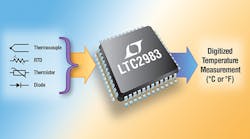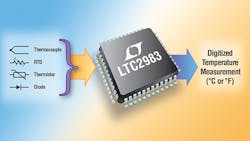This morning, the Monday of Thanksgiving week, Linear Technology introduced a new part that connects to any thermocouple, thermistor, or Resistance Temperature Detector (RTD) and digitizes the temperature being sensed to an accuracy of 0.1°C with 0.001°C resolution.
Quoting the press announcement: “The LTC2983 provides a multiplexed high precision interface to virtually any sensor. It precisely measures absolute microvolt level signals from thermocouples and ratiometric resistance measurements from RTDs and thermistors, linearizes the results and outputs the results in °C or °F. Up to twenty analog inputs are available and digitized measurements can be output in Celsius or Fahrenheit. The SPI interface works with virtually any digital system and a comprehensive software support system with drop-down menus allows easy customizing.”
That’s a little terse. The data sheet, expands the specs with some bullet points:
· The LTC2983 interfaces with temperature sensors, including type B, E, J, K, N, S, R, T, thermocouples, 2,3, or 4-wire RTDs, 2.25kΩ to 30kΩ thermistors and temperature sensing diodes.”
· It works with ground-referenced sensors without the need for amplifiers, negative supplies, or level-shift circuitry.
· Signals are simultaneously digitized by three 24-bit ΔΣ ADCs using an internal 10-ppm/°C reference.
· Automatic thermocouple cold junction compensation can be accomplished using any type of external sensor.
· The digital part of the chip includes linearization algorithms for all common sensor types, and custom sensors can be linearized with custom coefficients.
· There are dual programmable excitation current sources with current reversal and current ranging capabilities. (Current reversal eliminates thermocouple effects in the resistive sensor.)
Linear’s mixed-signal VP, Robert Reay explained the technology to me one day last week, but all along, I had a sense of déjà vu. That turned out to be the late Jim Williams, Linear’s master of appnotes, and tireless researcher into the roots of anything electronic, whispering in my ear.
Thanks to Linear, I have both volumes of Jim’s appnotes in hard-cover (I hear there’s a third volume coming out soon.), and I have spent some time browsing them. (The appnotes are downloadable from Linear’s website, and the current two volumes, in hard cover, can be ordered from a different location on the site
The appnote I was remembering was number 28, from February 1988, called, simply, “Thermocouple Measurement.”
Jim takes the reader right back to Thomas Seebeck, in1822, and examines all the nuances of using electricity to measure absolute temperatures. And he goes into the problems – which come down to all the ways that the calibration curves for all the different kinds of temperature sensing devices are frustratingly non-linear. And that’s the real problem the new part solves: all the different curves are already modeled inside the chip.
You couldn’t do that back then and the old appnote provides some remarkable insights into the way Jim’s mind worked. He was always looking for the causes of problems and solutions to those problems that were not mere patches, real examples of the art of engineering.
And, of course back in 1988, Linear had a solution for the temperature reading challenge, and that’s what Jim wrote the appnote to explain. But the old solution’s not nearly as precise, accurate, and elegant as the LTC2983. And I like to think of him somewhere, smiling approval. They finally got it.
And if you’re wondering what it costs, the announcement says that thousand-unit pricing is $19.49 each.

